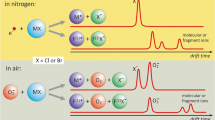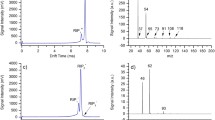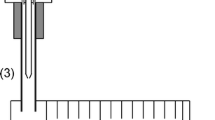Abstract
For the ionization of gas mixtures, several ionization sources can be coupled to an ion mobility spectrometer. Radioactive sources, e.g. beta radiators like 63Ni and 3H, are the most commonly used ionization sources. However, due to legal restrictions radioactive ionization sources are not applicable in certain applications. Non-radioactive alternatives are corona discharge ionization sources or photoionization sources. However, using an electron gun allows regulation of ion production rate, ionization time and recombination time by simply changing the operating parameters, which can be utilized to enhance the analytical performance of ion mobility spectrometers. In this work, the impact of an ionization source parameter variation on the ion mobility spectrum is demonstrated. Increasing the ion production rate, the amount of the generated ions increases leading to higher signal intensity while the noise remains constant. Thus, the signal to noise ratio can be increased, leading to better limits of detection. In a next step, the ion production rate is kept constant while the influence of ionization time on the ion mobility spectrum is investigated. It is shown, that varying the ionization time allows the determination of the reaction rate constants as additional information to the ion mobility. Furthermore, we show the prevention of discrimination processes by using short ionization times combined with an increased ion production rate. Thus, the limit of detection for benzene in presence of toluene is improved. Additionally, it is shown that using ion-ion recombination leads to the detection of the ion species with the highest proton affinity at higher recombination times while the low proton affine ions already recombined. Thus, the measurement of the ion mobility spectra at a defined recombination time allows a suppression of disturbing low proton affine substances.










Similar content being viewed by others
References
Borsdorf H, Eiceman GA (2006) Ion mobility spectrometry: principles and applications. Appl Spectrosc Rev 41(4):323–375
Chen YH, Hill HH, Wittmer DP (1996) Thermal effects on electrospray ionization ion mobility spectrometry. Int J Mass Spectrom Ion Process 154(1–2):1–13
Kanu AB, Haigh PE, Hill HH (2005) Surface detection of chemical warfare agent simulants and degradation products. Anal Chim Acta 553(1–2):148–159
Kanu AB, Hill HH (2007) Identity confirmation of drugs and explosives in ion mobility spectrometry using a secondary drift gas. Talanta 73(4):692–699
Ewing RG, Atkinson DA, Eiceman GA, Ewing GJ (2001) A critical review of ion mobility spectrometry for the detection of explosives and explosive related compounds. Talanta 54(3):515–529
Ungethüm B, Walte A, Münchmeyer W, Matz G (2009) Comparative measurements of toxic industrial compounds with a differential mobility spectrometer and a time of flight ion mobility spectrometer. Int J Ion Mobil Spectrom 12(4):131–137
Wu C et al. (2002) Construction and characterization of a high-flow, high-resolution ion mobility spectrometer for detection of explosives after personnel portal sampling. Talanta 57(1):123–134
Karpas Z (2013) Applications of ion mobility spectrometry (IMS) in the field of foodomics. Food Res Int 54(1):1146–1151
Vautz W et al. (2006) Ion mobility spectrometry for food quality and safety. Food Addit Contam 23(11):1064–1073
Vautz W et al. (2010) Breath sampling control for medical application. Int J Ion Mobil Spectrom 13(1):41–46
Cochems P, Kirk A, Zimmermann S (2014) In-circuit-measurement of parasitic elements in high gain high bandwidth low noise transimpedance amplifiers. The Review of scientific instruments 85(12):124703
Kirk AT, Zimmermann S (2015) Pushing a compact 15 cm long ultra-high resolution drift tube ion mobility spectrometer with R = 250 to R = 425 using peak deconvolution. Int J Ion Mobil Spectrom 18(1–2):17–22
Hill HH, Siems WF, Louis S, Robert H (1990) Ion mobility spectrometry. Anal Chem 62(23):1201 A–1209 A
Leonhardt JW (1996) New detectors in environmental monitoring using tritium sources. J Radioanal Nucl Chem Artic 206(2):333–339
Sabo M et al. (2011) Positive corona discharge ion source with IMS/MS to detect impurities in high purity Nitrogen. Eur Phys J Appl Phys 55(1):13808
Sabo M, Matejčík Š (2012) Corona discharge ion mobility spectrometry with orthogonal acceleration time of flight mass spectrometry for monitoring of volatile organic compounds. Anal Chem 84(12):5327–5334
Kauppila TJ, Kersten H, Benter T (2014) The ionization mechanisms in direct and dopant-assisted atmospheric pressure photoionization and atmospheric pressure laser ionization. J Am Soc Mass Spectrom 25(11):1870–1881
Matsaev V, Gumerov M, Krasnobaev L, Pershenkov V, Belyakov V, Christyakov A, Boudovitch V (2002) IMS Spectrometers with Radioactive, X-ray, UV and Laser Ionization. Int J Ion Mobil Spectrom 5(3):112–114
Reinecke T et al. (2016) A compact high-resolution X-ray ion mobility spectrometer. The Review of scientific instruments 87(5):53120
P. Cochems et al, “Fast pulsed operation of a small non-radioactive electron source with continuous emission current control,” The Review of scientific instruments, vol. 86, no. 6, p. 65102, 2015.
Liedtke S et al. (2016) Medium Vacuum Electron Emitter as Soft Atmospheric Pressure Chemical Ionization Source for Organic Molecules. Anal Chem 88(9):5003–5008
Morozov A, Krücken R, Wieser J, Ulrich A (2005) Gas kinetic studies using a table-top set-up with electron beam excitation: quenching of molecular nitrogen emission by water vapour. Eur Phys J D 33(2):207–211
Heptner A, Cochems P, Langejuergen J, Gunzer F, Zimmermann S (2012) Investigation of ion-ion-recombination at atmospheric pressure with a pulsed electron gun. Analyst 137(21):5105–5112
Kirk AT, Allers M, Cochems P, Langejuergen J, Zimmermann S (2013) A compact high resolution ion mobility spectrometer for fast trace gas analysis. Analyst 138(18):5200–5207
Eiceman GA, Karpas Z, Hill HH (2013) Ion mobility spectrometry, 3rd edn. CRC Press, Boca Raton
Kirk AT, Zimmermann S (2014) Bradbury-Nielsen vs. Field switching shutters for high resolution drift tube ion mobility spectrometers. Int J Ion Mobil Spectrom 17(3–4):131–137
Loeb L, Kip A, Hudson G, Bennett W (1941) Pulses in Negative Point-to-Plane Corona. Phys Rev 60(10):714–722
Loeb LB (ed) (1960) Basic processes of gaseous electronics. Univ. of California Press, California
Carr TW (1984) Plasma chromatography. Plenum Press, New York
Earl W (1993) McDaniel, Ed, Atomic collisions heavy particle projectiles. New York, Chichester, UK, Brisbane, Toronto, Singapore, John Wiley & Sons, Inc
Gunzer F (2015) Investigation of the ion signal decay in the reaction region of a pulsed ion mobility spectrometer. Int J Ion Mobil Spectrom 18(1–2):41–49
Puton J, Holopainen SI, Mäkinen MA, Sillanpää MET (2012) Quantitative response of IMS detector for mixtures containing two active components. Anal Chem 84(21):9131–9138
Langejuergen J, Allers M, Oermann J, Kirk A, Zimmermann S (2014) Quantitative detection of benzene in toluene- and xylene-rich atmospheres using high-kinetic-energy ion mobility spectrometry (IMS). Anal Chem 86(23):11841–11846
“Overall evaluations of carcinogenicity: an updating of IARC Monographs volumes 1 to 42,” IARC Monogr Eval Carcinog Risks Hum Suppl, vol. 7, pp. 1–440, 1987.
Heptner A, Reinecke T, Langejuergen J, Zimmermann S (2014) A gated atmospheric pressure drift tube ion mobility spectrometer-time-of-flight mass spectrometer. J Chromatogr A 1356:241–248
Puton J, Nousiainen M, Sillanpää M (2008) Ion mobility spectrometers with doped gases. Talanta 76(5):978–987
Acknowledgments
This research is funded by the German Research Foundation (DFG).
Author information
Authors and Affiliations
Corresponding author
Rights and permissions
About this article
Cite this article
Heptner, A., Angerstein, N., Reinecke, T. et al. Improving the analytical performance of ion mobility spectrometer using a non-radioactive electron source. Int. J. Ion Mobil. Spec. 19, 175–182 (2016). https://doi.org/10.1007/s12127-016-0205-4
Received:
Revised:
Accepted:
Published:
Issue Date:
DOI: https://doi.org/10.1007/s12127-016-0205-4




